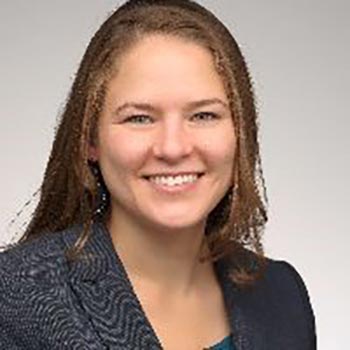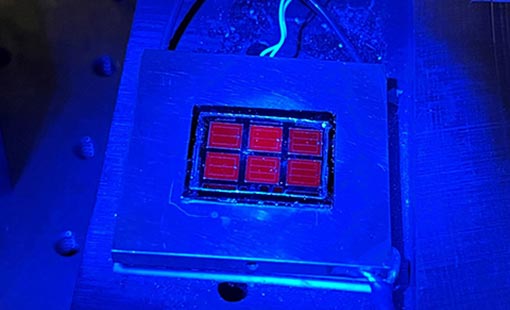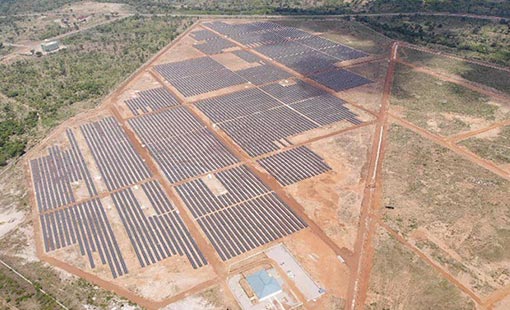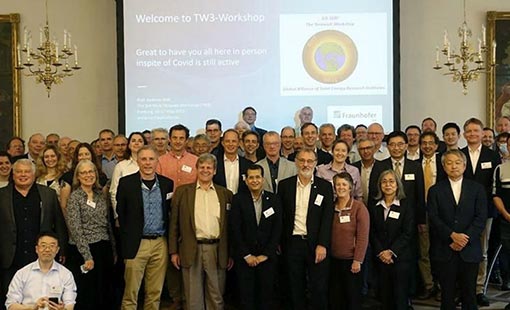Solar Newsletter—June 2022
The Solar Newsletter is an electronic newsletter that provides information about NREL's research and development of solar technologies.
Subscribe to the Solar Newsletter or see the archives.
NREL Creates Highest Efficiency 1-Sun Solar Cell
Not only does the latest III-V solar cell from NREL set a world-record efficiency of 39.5% under 1-sun illumination, but it also does so with only a triple-junction design. This cell uses quantum wells to precisely tune three absorbing layers, making the world-record cell simple in design compared to previous record cells.
Powering Ghana: Developing the First Hydro-Solar Plant in West Africa
The first West African hydro-solar plant was deployed in Ghana in January, with technical support from the United States Agency for International Development and NREL. Adding photovoltaic (PV) to the hydro plant allows the local power authority to balance solar generation by increasing or decreasing hydro generation.
World's Leading Solar Energy Research Institutions Gather at Third Terawatt Workshop
As of May 2022, the world has installed 1 terawatt of PV capacity! With that context, NREL PV researchers joined other leading solar research institutes for the Third Terawatt Workshop. Discussion centered around material availability and supply chains for a multi-terawatt PV industry.
Remote and Island Communities Pursue Energy Resilience
Twelve new remote U.S. communities have been selected to participate in a U.S. Department of Energy program to address their local energy resilience challenges. With the help of NREL and other labs, the communities will explore options, including solar.
Meet the Solar District Cup Class of 2021–2022 Winners
The Solar District Cup challenges student teams to develop systems that integrate solar, storage, and other distributed energy capabilities across mixed-use districts. After presenting their designs to industry judges, nine student-led teams won first, second, or third place across three divisions.
Research Highlights
Spring 2022 Solar Industry Update, NREL Presentation (2022)
PV Reference Cells for Outdoor Use: Comparison of First-Year Field Measurements, NREL Subcontractor Report (2022)
Enhanced Control, Optimization, and Integration of Distributed Energy Applications
(ECO-IDEA), NREL Technical Report (2022)
Assessing the New Home Market Opportunity: Case Study and Cost Modeling for Solar and Storage in 2030, NREL Technical Report (2022)
Upcoming Events
July 11 – Webinar: PV Soiling and Performance Losses, Durable Module Materials Consortium
July 21 – Webinar: Automated Solar Permitting Roundtable for Industry and Local Governments, International Code Council
July 28 – Submission Deadline: Perovskite Startup Prize, American-Made Challenges
Staff Profile – Bethany Frew

Group Manager
Capacity Expansion and Electricity Markets
Grid Planning and Analysis Center
When Bethany Frew started at NREL as a postdoctoral researcher, she spent a large
portion of her time improving solar capabilities in the Regional Energy Deployment
System (ReEDS™) model—NREL’s flagship capacity planning model for the power sector. Over the past
8 years, she has continued to use the ReEDS and other power system models to explore
the role of solar in future power systems. Most recently, Frew investigated solar
curtailment—the reduction of renewable energy delivered due to oversupply or lack
of system flexibility—in high variable renewable energy futures.
Her research reveals that U.S. power grids in 2050—when 55% of the country's annual
electricity could come from solar—could meet all energy demand and operating reserve
requirements for all hours while considering key generator operational constraints,
but it would require high levels of curtailment and energy storage. In a complementary study, Frew discovered a “curtailment paradox,” where flexibility options and curtailment in power systems with high solar penetration
have a counterintuitive relationship.
“My passion for the environment and sustainability drive everything I do at NREL.
There are so many interesting questions to explore about grid integration of high
levels of variable renewable energy.”
Share





